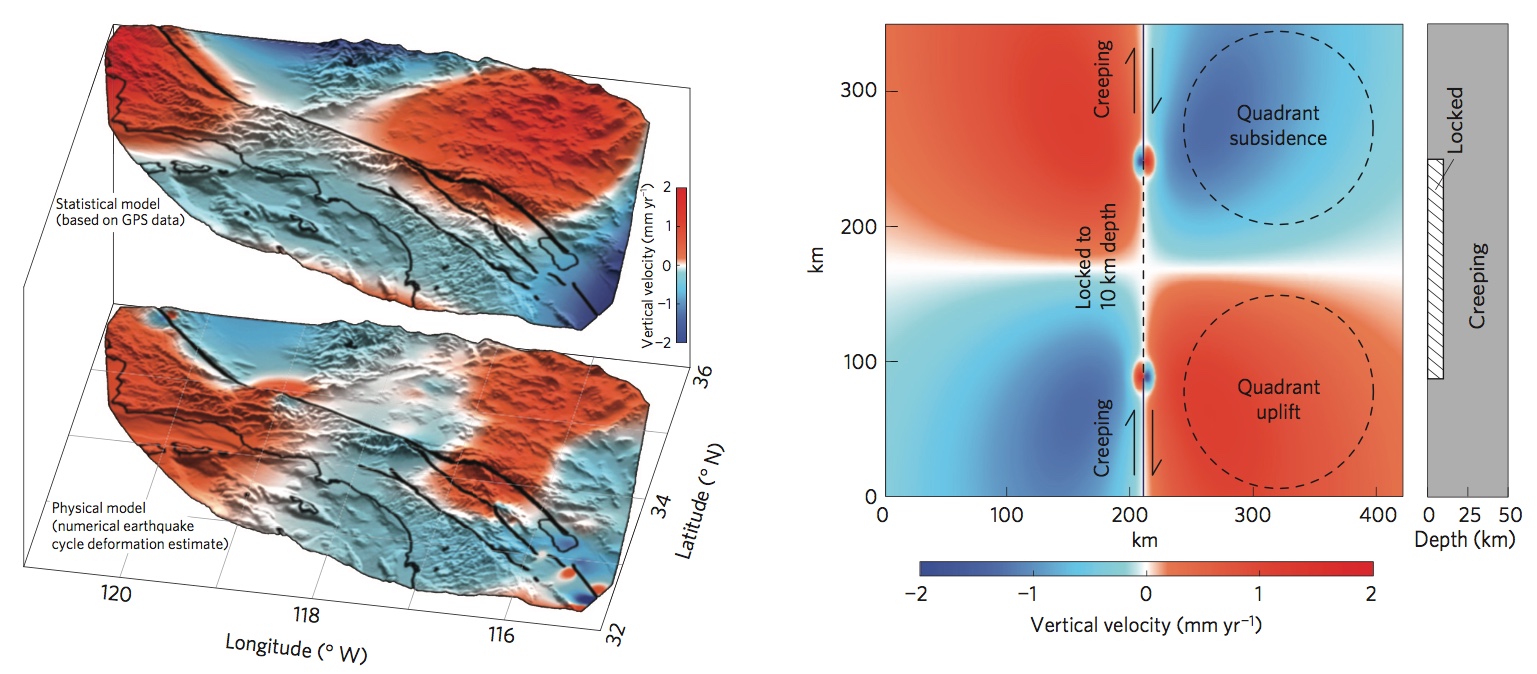The primary objective of our groupʻs research is to improve our understanding of the earthquake cycle through sophisticated computer models of fault system deformation constrained by geologic, geodetic, and seismic data. Plate boundary interactions, like those characterizing the behavior of the San Andreas Fault System, have been vigorously deforming much of the Earth's crust for over the past several million years. Recognized as the most widely researched fault system in the world, the San Andreas has become a natural laboratory for investigating the many facets of plate boundary deformation revealed by a synthesis of geologic, geodetic, and seismic observations.

To model lithospheric deformation of the San Andreas Fault System associated with the earthquake cycle, my group uses a semi-analytical Fourier model that calculates the 3D response of both elastic and viscoelastic mediums to a distribution of body forces. Merging data from the historical & prehistorical earthquake database with geologic and geodetic observations, these models allows for both large-scale and long-term deformation simulations of the earthquake cycle. To date, we have used this method to investigate 1000-year earthquake scenario models of the San Andreas Fault System. Stress evolution models, simulating interseismic, coseismic, and postseismic changes over the past 400 years, were also constructed based on these findings.
Related Publications:
Smith-Konter, B; L. Burkhard, L. Ward, X. Xu, P. Wessel, and D.T. Sandwell (2020), San Andreas Fault System stress evolution (1600-2020), https://doi.org/10.6084/m9.figshare.12900005.
Xu, X., L. Ward, J. Jiang, B. Smith-Konter, E. Tymofyeyeva, E. O. Lindsey, A. G. Sylvester and D.T. Sandwell (2018), Surface creep rate of the Southern San Andreas Fault modulated by stress perturbations from nearby large events, Geophys. Res. Lett., doi: 10.1029/2018GL080137.
Luttrell, K. and B. Smith-Konter (2017), Limits on crustal differential stress in southern California from topography and earthquake focal mechanisms, Geophys J. Int., doi: 10.1093/gji/ggx301.
Howell, S., B. Smith-Konter, N. Frazer, X. Tong, and D.T. Sandwell (2015), The vertical fingerprint of earthquake-cycle loading in Southern California, Nature Geosciences, doi: 10.1093/2015-03-04591.
Tong, X., D.T. Sandwell, and B. Smith-Konter (2015), An integral method to estimate the moment accumulation rate on the Creeping Section of the San Andreas Fault, Geophys. J. Int., doi: 10.1093/gji/gjis140783.
Smith-Konter, B., G.M. Thornton, and D.T. Sandwell (2014), Vertical crustal displacement due to interseismic deformation along the San Andreas fault: Constraints from tide gauges, Geophys. Res. Lett., doi:10.1029/2014GL060091.
Del Pardo, C., B. Smith-Konter, C.Kreemer, G. Blewitt, W. Hammond, and L. Serpa (2012), Interseismic deformation and stress evolution of the Death Valley Fault Zone, J. Geophys. Res., 117, B060404, doi:10.1029/2011JB008552.
Smith-Konter, B., D. Sandwell, and P. Shearer (2011), Locking depths estimated from geodesy and seismology along the San Andreas Fault System: Implications for seismic moment release, J. Geophys. Res., 116, B06401, doi:10.1029/2010JB008117.
Smith-Konter, B., D. Sandwell, and M. Wei (2010), Integrating GPS and InSAR to resolve stressing rates of the SAF System, EarthScope inSights Newsletter, Summer 2010.
Wei, M., D. Sandwell, and Smith-Konter, B. (2010), Optimal combination of InSAR and GPS for measuring interseismic crustal deformation, J. Adv. in Space Res., doi: 10.1016/j.asr.2010.03.013.
Smith-Konter, B., and D.T. Sandwell (2009), Stress evolution of the San Andreas Fault System: Recurrence interval versus locking depth, Geophys. Res. Lett., 36, doi:10.1029/2009GL037235.
Luttrell, K., D.T. Sandwell, B. Smith-Konter, B. Bills, and Y. Bock (2007), Modulation of the earthquake cycle at the southern San Andreas fault by lake loading, Journal of Geophysical Research, 112, doi:10.1029/2006JB004752.
Smith, B.R. and D.T. Sandwell (2006), A model of the earthquake cycle along the San Andreas Fault System over the past 1000 years, J. Geophys. Res., 111, doi:10.1029/2005JB003703.
Smith, B. R. and D. T. Sandwell (2003), Coulomb stress along the San Andreas Fault System, J. Geophys. Res., 108, doi:10.1029/2002JB002136.

